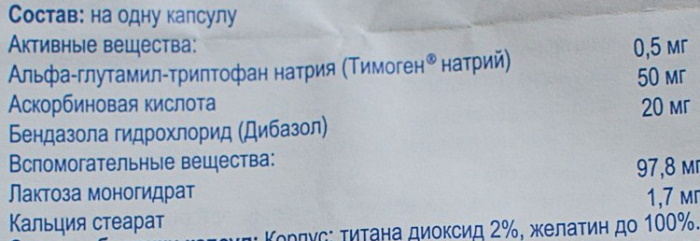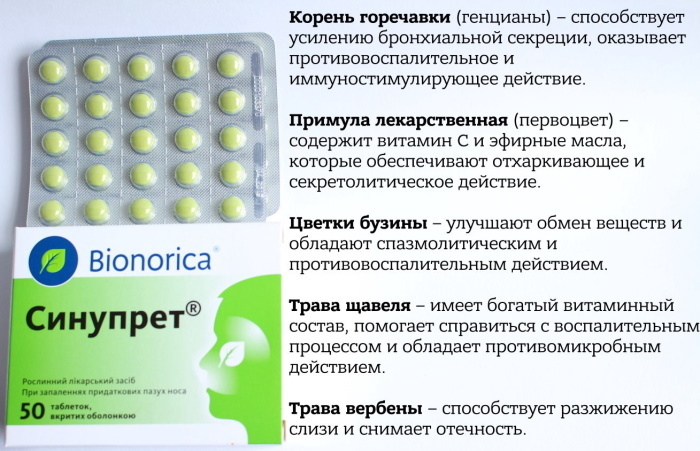Content
- Fixed assets in tablets
- Antipyretic
- Antispasmodic
- Antihistamine
- What drugs can be replaced
- The composition of drugs in injections
- Antipyretic
- Antispasmodic
- Antihistamine
- What can be replaced
- Lytic Blend Video
Antipyretic drugs are the most common group of drugs found in home medicine kits. If there are children in the house, a special dosage form is purchased for them, more often in the form of a syrup or suppositories, the dosage of the active substance in which differs significantly from that in tablets for adults. But these funds do not always help, then you have to call a doctor, who instantly knocks down the fever with a triad.
Troichatka is not just a means to normalize the temperature. This is a special combination of several powerful drugs, the use of which is permissible only by doctors and according to strict indications. The use of triad as part of self-medication can lead to loss of consciousness, heart rhythm disturbances, gastric bleeding, and other dire consequences.
Fixed assets in tablets
Troichetka is a complex of 3 main substances:
- antipyretic;
- antispasmodic;
- antihistamine.
Each group of drugs comes in several dosage forms, the most popular of which is tablets. They have their disadvantage - the effect of the drug mixture does not start immediately. It will take at least 40 minutes before the patient feels relief. In some patients, there is a delay in the expected effect associated with impaired absorption in the small intestine.
For children, the tablet form is not the form of choice. For a child under 3 years old, pills are completely contraindicated, as they pose a threat of blockage of the respiratory tract. For the treatment of this age group, it is correct to make the choice in favor of syrups or suppositories, since swallowing a pill and not every preschool patient can not choke, especially during an acute course diseases.
Antipyretic
Troychatka from temperature for children, the dosage of which is calculated in accordance with the patient's weight, includes analgin as an antipyretic agent. This substance belongs to the group of non-steroidal anti-inflammatory drugs, it is one of the very first non-narcotic drugs that have been invented by mankind.
Analgin is one of the trade names of the drug. The active ingredient of analgin is metamizole sodium.
It has three actions:
- anesthesia;
- decrease in body temperature to normal values;
- reducing the severity of inflammation.
However, he is kept in the home medicine cabinet, as a rule, in order to eliminate pain. For the symptomatic treatment of children with ARVI, analgin is not recommended, since it has the ability to negatively affect the hematopoietic system. With frequent use, the agent significantly reduces the number of platelets and leukocytes. That ultimately can even lead to death. The longer analgin is used, the higher the degree of the inhibitory effect on the hematopoietic system.
However, with a single use, even in high doses, analgin almost never becomes the cause of the development of pathological processes. At the same time, analgin shows high efficiency in comparison with other antipyretic drugs. In this connection, the ambulance team always has it in its arsenal in order to quickly prevent fever in the patient.
In case of emergency, when safer drugs that lower body temperature do not cope with their task, and the child has a fever, a single dose is calculated based on the patient's body weight: for 1 kg of weight, take from 5 to 10 mg analgin. For children of the first half of life, treatment with analgin is strictly contraindicated in the absence of other instructions from the attending physician.
An example of calculating a single dose is shown in the table:
| Child's age, g | Child's weight, kg | Single estimated dose, mg |
| 1 | 8,5 -11,6 | 40-110 |
| 2 | 10,8-14,2 | 55-140 |
| 3 | 12,5-16,9 | 60-169 |
| 4 | 14-19 | 70-190 |
| 5 | 15,7-21 | 78-210 |
| 6 | 17,7-24,3 | 85-243 |
| 7 | 19,4-26 | 97-250 |
| 8 | 21,5-28,3 | 107-283 |
| 9 | 23,5-31,1 | 117-300 |
| 10 | 25,6-39,5 | 128-300 |
| 11 | 28-39,9 | 140-300 |
| 12 | 30,7-45 | 153-300 |
| 13 | 33,8-50,6 | 170-300 |
| 14 | 38-52 | 190-300 |
| 15 | 43,5-53 | 220-300 |
| 16 | 48,3-54 | 240-300 |
| 17 | 49,2-55,3 | 250-300 |

The maximum permitted single dose for a child should not exceed 300 mg, therefore, for large children weighing more than 30 kg, body weight no longer matters - they are given 300 mg of analgin at a time.
Troichetka from temperature for children, the dosage of which is measured by a medical specialist, is used only in emergency cases, therefore, for a child in serious condition due to fever, it is allowed to opt for the upper limit norms.
It is important for parents to understand that bringing down the temperature of a child does not mean curing. Fever, which has arisen against the background of an infectious disease, is the body's method of fighting the pathogen. When the temperature rises, the cells of the circulatory system receive a command to mobilize, while interferon is produced, the bactericidal activity of polynuclear cells increases, which absorb harmful particles.
Knocking down the temperature at home without explicit indications is the first step to reducing the body's ability to resist the development of the disease. With the help of antipyretic drugs, it is advisable to fight fever only when the thermometer has risen above 38.5 ℃.
The following situations are exceptions:
- the child has a history of febrile seizures;
- the age of the patient is up to 3 months (the choice of the drug and the dosage is carried out only by the pediatrician);
- diagnosed with a pathology of the central nervous system;
- the presence of chronic heart disease;
- congenital or acquired lung pathology.
Regardless of how easily a child tolerates an increase in temperature, with the so-called "white" fever, taking an antipyretic agent is necessary. White fever is a condition in which a child's cheeks are not flushed, he looks pale. With internal hyperthermia, he freezes, hands and feet may be cold.
This condition occurs against the background of vasospasm. The body produces an excess amount of heat, but it cannot give it away, because the vessels are narrowed. Heat accumulates around internal organs, increasing the risk of overheating, which can lead to brain edema and the onset of irreversible protein breakdown.
In case of "white" fever, the use of triad is vital if the child's form of antipyretic drug does not give a positive result one hour after taking it. The presence of two auxiliary components in the composition quickly relieves the patient's condition.
Antispasmodic
An antispasmodic is needed as part of a triad in order to relax smooth muscles. It covers not only the abdominal organs, but also the bloodstream. Relieving spasm, the drug helps capillaries and small vessels to relax and respond correctly to an increase in body temperature - expansion.
In this state, the body, while still continuing to produce excess heat, can effectively release it. Due to this, even high rates, close to 39-40 ℃, do not carry the same level of danger as with vasospasm. Due to the fact that the tablet form of the antipyretic agent begins to act after 40-60 minutes after ingestion, relaxation of blood vessels with an antispasmodic is an important stage in reducing the risks of development complications.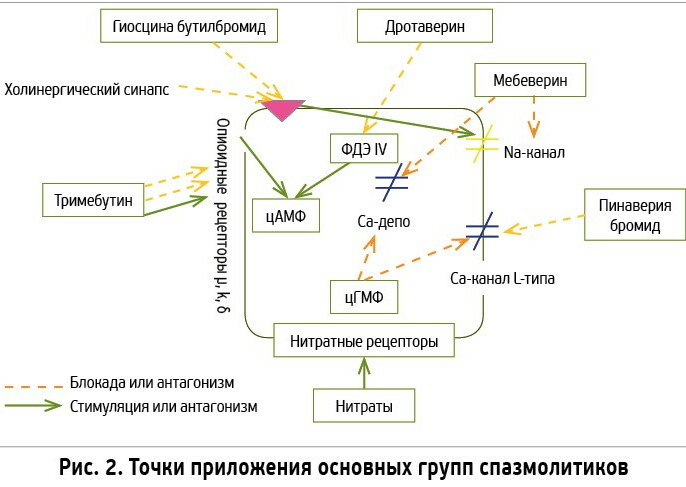
Papaverine is used as the main drug that relieves vasospasm. Due to the fact that the tablet can only be swallowed by a child over 3 years old, for younger patients it is better to choose the medicine in liquid form, for example, in the form of a solution for intramuscular or intravenous introduction. A single dose for a child should not exceed 20 mg.
One papaverine tablet may contain 20 or 40 mg of the active substance. Therefore, in order to measure the permitted amount of the product, it may be necessary to divide one tablet in half (for tablets containing 40 mg of papaverine hydrochloride).
Antihistamine
Antihistamines are drugs that can influence the biotransformation of histamine, a substance released by mast cells in response to contact with an allergen. However, these agents are not added to the lytic mixture because the allergy caused the fever.
Medical practice and numerous studies have shown that antihistamines have some additional properties in addition to inhibiting the activity of histamine. This is a sedative and potentiating effect.
Diphenhydramine is primarily used as a drug in the triad. This is due to the fact that it is in diphenhydramine that the potentiating abilities are most pronounced than in similar drugs in this group. For children, there is a special type of tablets - in a dosage of 20 mg, which makes it easier to take.
Troychatka from temperature for children, the dosage of diphenhydramine in which should not exceed the average therapeutic, owes its effectiveness to the potentiating effect of the antihistamine component. In addition, if edema is observed in a patient with a fever, diphenhydramine will help to eliminate it or reduce its severity. This is especially important for bronchitis, laryngitis, and croup.
In addition, diphenhydramine has another important function - it has an antiemetic effect. Vomiting is a pathological loss of fluid in the body. When the temperature is high, it is extremely important to be able to water the baby to avoid dehydration.
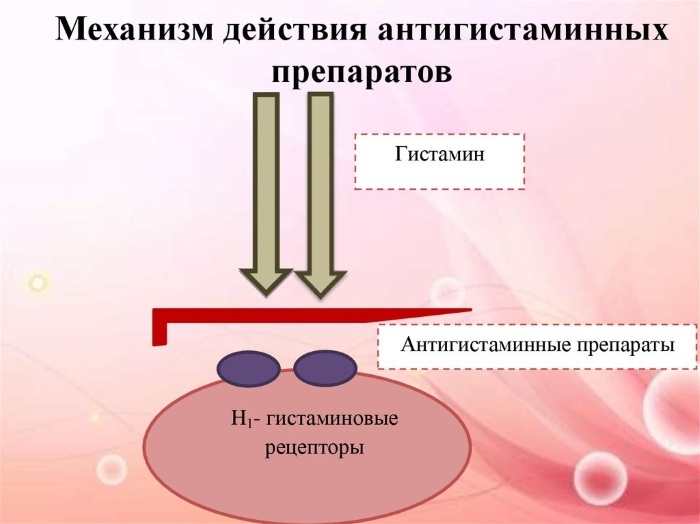
High sweating is an integral part of hyperthermia. The main task of parents at a high temperature in a child is to replenish the loss of fluid with frequent and abundant drinking. But when vomiting opens up, this becomes a difficult task. Diphenhydramine, accelerating the effect of analgin, at the same time prevents vomiting.
What drugs can be replaced
Due to the fact that each drug has its own number of contraindications, among which in the first place there is always an individual intolerance to the components of each, the doctor has a list of analogues for replacement.
Analgin is not the drug of choice in the fight against high fever in a child. It is used as a component of the triad because its antipyretic effect is more pronounced, which is very important in the matter of emergency care. However, if metamizole sodium is intolerant, safer drugs are used: paracetamol and ibuprofen.
Paracetamol has a faster antipyretic effect, but ibuprofen lasts longer. The tablet form of paracetamol is approved for use from the age of 6. The dose size is calculated according to the patient's weight, but not more than 250 mg for children from 6 to 10 years old, and not more than 500 mg for children from 10 to 18 years old.
The permitted single dosage is shown in the table:
| Age, years | Child's weight, kg | Single volume of paracetamol, mg |
| 6 | 17,7-24,3 | 170-250 |
| 7 | 19,4-26 | 190-250 |
| 8 | 21,5-28,3 | 210-250 |
| 9 | 23,5-31,1 | 250 |
| 10 | 25,6-39,5 | 250 |
| 11 | 28-39,9 | 280-500 |
| 12 | 30,7-45 | 300-500 |
| 13 | 33,8-50,6 | 330-500 |
| 14 | 38-52 | 380-500 |
| 15 | 43,5-53 | 430-500 |
| 16 | 48,3-54 | 500 |
| 17 | 49,2-55,3 | 500 |
Troichetka, which contains ibuprofen in tablets, is used to relieve fever in children over 6 years old. A single dosage is 200 mg. If the patient weighs less than 20 kg, it is recommended to use ibuprofen in other dosage forms.
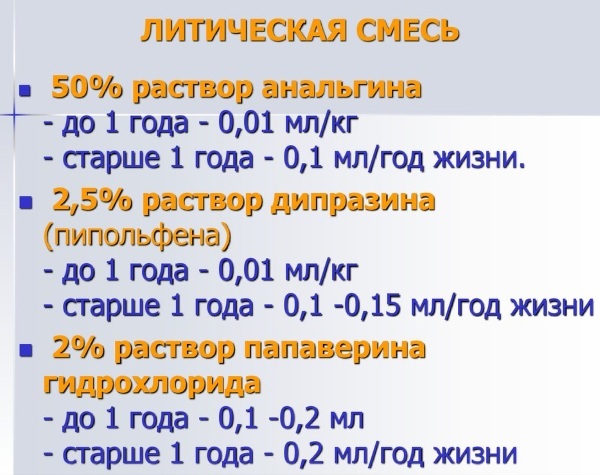
Papaverine can be replaced with drotaverine when the child has an intolerance to the first drug. However, both papaverine and drotaverine are contraindicated for the treatment of children under 6 years of age. The limitation applies only to the tablet form of release, therefore, the triad for young patients is allowed to be used only in the form of injections.
An analogue of diphenhydramine in a lytic mixture can be suprastin or tavegil. Suprastin is released in tablets, each of which contains 25 mg of the active substance, which is equal to a one-time intake. Suprastin can be used in the treatment of children from 3 years of age.
Tavegil tablets are approved for the treatment of children from 6 years of age. Young patients are shown the liquid form of the drug. Once a child from 6 years old can be given 1 tablet, which is equal to 1 mg of the active substance.
The composition of drugs in injections
A lytic mixture is most often a liquid form of drugs that are administered intravenously. This method of drug administration eliminates the need to wait 40-60 minutes for the first signs of relief. By introducing the triad directly into the bloodstream, the doctor provides an instant antipyretic and analgesic effect.
Antipyretic
When the lytic mixture is presented in the form of an intravenous solution, the effect of its use is immediate. As an antipyretic agent, analgin is primarily used.
In this case, the triad contains a 50% solution, the volume of which is calculated in accordance with the weight of the child:
- children of the first year of life 0.01 ml / kg;
- children over one year old - 0.1 ml / kg.
It is important to keep in mind that analgin often causes severe tissue irritation when it gets under the skin. This suggests that in the case of intramuscular injection, a long needle should be used, and it is important to feed the drug into the tissues slowly and evenly in order to avoid the formation of bumps and abscesses. The intravenous type of administration of the drug eliminates the risk of a post-injection lump, however, it can provoke a more terrible negative reaction - anaphylactic shock.
Antispasmodic
As an effective antispasmodic in the form of a solution, drotaverine, better known under the trade name No-Shpa, is usually used. In tablet form, it is contraindicated in children under 6 years old, and in the form of a solution, it is allowed from the first month of life. For patients from 0 to 6 years old, a single dose is half an ampoule, which is equal to 10 mg / ml of the drug. After 6 years, the patient can be administered a whole ampoule containing 20mg / ml drotaverine.
Antihistamine
Troichetka from temperature for children, the dosage and form of release of which is selected depending on age and weight child, when using a solution for parenteral administration as an antihistamine, includes diphenhydramine. Unlike the tablet form, the solution is approved for the treatment of children from 7 months.
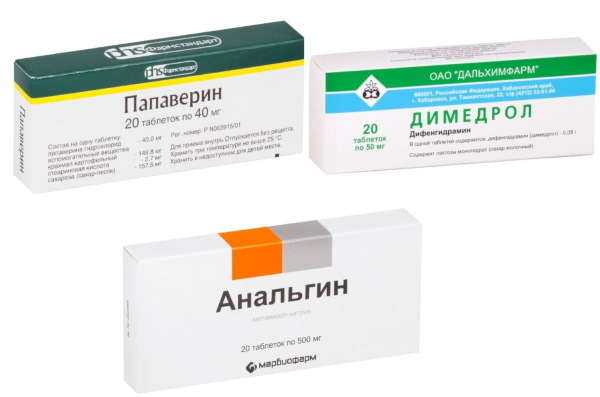
A single dosage is calculated as follows:
- from 7 to 12 months, 0.3-0.5 ml is injected once;
- from one to 3 years, the dose is from 0.5 to 1 ml;
- for patients 4-6 years old - from 1 to 1.5 ml;
- patients 7-14 years old are administered from 1.5 to 3 ml.
It is important to remember that the lytic mixture is used once, therefore, the one-time consumption rate of medicines is equal to the permissible daily dose. If the child does not feel better and needs to re-enter the triad, this should be done already in a hospital under the constant supervision of medical personnel.
What can be replaced
In case of intolerance to analgin, the substance can be replaced with chlorpromazine in a dosage of 0.5-1 ml of a 2.5% solution. Diazepam is given to children to replace diphenhydramine, especially if the fever is accompanied by prolonged convulsions. A 0.5% solution is used, for each kg of the child's body weight there should be up to 0.4 mg of the substance.
The absence of seizures and the impossibility of using diphenhydramine gives the doctor the right to use suprastin as a replacement.
The dose is calculated according to the following recommendations:
- children from 1 to 12 months - 0.25 ml each, which is a quarter of an ampoule;
- intramuscular administration is permissible for patients from one to 6 years old, in an amount of 0.5 ml, which is equal to half an ampoule;
- intramuscular injection for children from 6 years old should contain no more than 1 ml, which is equivalent to 1 ampoule.
If there is no drotaverine in the doctor's arsenal, or the patient does not tolerate this component of the lytic mixture, the substance can be replaced with papaverine. Its effectiveness is less pronounced, however, for children under 6 years of age, this is rather a plus, since excessive rigidity of smooth muscles is undesirable. The dosage of papaverine depends on the weight of the child and is not more than 0.3 mg per 1 kg of body weight. The drug is approved for patients from 6 months.
During the preparation of the triad, the doctor can use one sterile syringe. Each component is added to it in turn, carefully measuring the dosage, so that in one injection the entire mixture is injected into the child. The temperature after such a procedure quickly returns to normal. Intravenous administration of substances alternately is permissible only with a pre-installed catheter.
Author: Rudich Anastasia
Lytic Blend Video
How to bring down a high temperature in a child:

